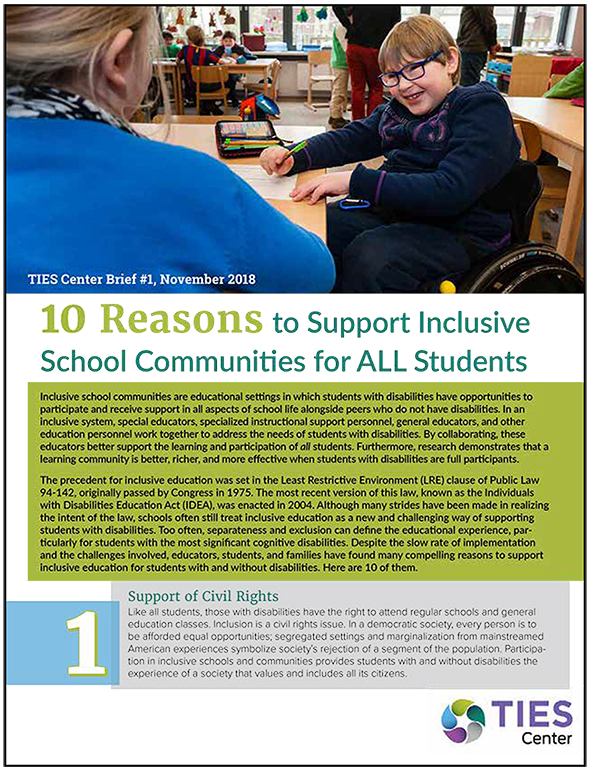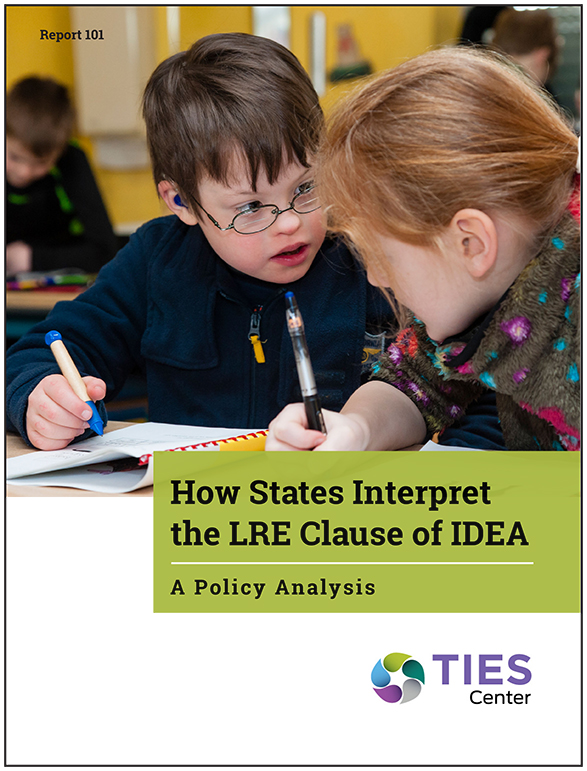TIES Center Publications
The NCEO-affiliated TIES Center (The National Technical Assistance Center on Inclusive Policies and Practices for Students with the Most Significant Cognitive Disabilities) has two new publications and a Facebook page.
 The new electronic interactive Brief, 10 Reasons to Support Inclusive School Communities for ALL Students, can be used by educators and family members to talk with one another and others about the importance of creating and supporting inclusive school communities. The ten reasons are:
The new electronic interactive Brief, 10 Reasons to Support Inclusive School Communities for ALL Students, can be used by educators and family members to talk with one another and others about the importance of creating and supporting inclusive school communities. The ten reasons are:
- Support of civil rights
- Integration in community life
- A sense of belonging and acceptance of differences
- Varied learning opportunities
- Use of best practices in instruction
- An individualized education in a supportive context
- Increased opportunities to establish relationships with peers
- Increased instructional support for all students
- Improved schools through team building
- Greater parental involvement
The brief is available at https://ici.umn.edu/products/briefs/inclusive-school-communities-10-reasons/#Cover
You can also download a printable accessible PDF version of the Brief at https://files.tiescenter.org/files/fQRF_9Cm4D/ties-brief-1.pdf
 The report How States Interpret the LRE Clause of IDEA: A Policy Analysis examines how states interpret special education regulations associated with the Individuals with Disabilities Education (IDEA) act, regulations around the least restrictive environment (LRE) clause, the continuum of alternative placements, and the placement for students with disabilities. The analysis shows that states vary in their interpretations of the federal regulations. While some states do not elaborate on federal regulations, others include substantial elaboration or adjustments to federal regulations. Given that policy is to act as a guide for practice, it is no surprise that states vary greatly in terms of placement of students with disabilities along the continuum. Based on the findings of this analysis, several recommendations are provided about how states might refine the ways in which they address LRE and placement.
The report How States Interpret the LRE Clause of IDEA: A Policy Analysis examines how states interpret special education regulations associated with the Individuals with Disabilities Education (IDEA) act, regulations around the least restrictive environment (LRE) clause, the continuum of alternative placements, and the placement for students with disabilities. The analysis shows that states vary in their interpretations of the federal regulations. While some states do not elaborate on federal regulations, others include substantial elaboration or adjustments to federal regulations. Given that policy is to act as a guide for practice, it is no surprise that states vary greatly in terms of placement of students with disabilities along the continuum. Based on the findings of this analysis, several recommendations are provided about how states might refine the ways in which they address LRE and placement.
The report is available at https://files.tiescenter.org/files/4xcNEHmmy-/ties-center-report-101.pdf
TIES Center Facebook page
![]() TIES Center recently launched its Facebook page. Follow TIES to learn more about upcoming conference presentations, publications, and other TIES activities.
TIES Center recently launched its Facebook page. Follow TIES to learn more about upcoming conference presentations, publications, and other TIES activities.
